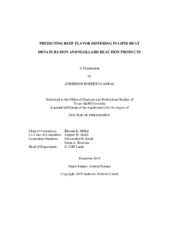| dc.description.abstract | The objective of this project was to evaluate how initial differences in raw beef lipid oxidation affects the development of beef flavor attributes and volatile aroma compounds using three cooking methods. Our hypothesis was that components of beef flavor in whole muscle beef top loin steaks would be affected by the level of raw lipid oxidation and cooking method. The level of lipid oxidation and cooking method affected flavor attributes of top loin steaks. This is expected because lipid oxidation creates off-flavors that can be detected by trained panelists and the cooking methods used in this project created different levels of Maillard reaction products and they were detected by the trained panelists from brown and roasted flavor descriptors.
The grill treatment was responsible for the development of more products from the Maillard reaction and these products were responsible for producing more positive flavor attributes as detected by the trained panelists, and producing more pyrazines and Strecker aldehydes. The steaks from the grill cooking treatment were more tender than the other cooking treatments from the mechanical measurements but the trained panelists did not perceive tenderness differences between the cooking methods. All three cooking methods affected tenderness, with all the treatments being “very tender” and “tender” steaks. However, the panelists described the steaks from the sous-vide treatments as denser. The Maillard products created from the grill cooking methods were able to mask some off-flavors creating positive flavors overall. The raw level of lipid oxidation was responsible for changes in the objective color measurements. This study was able to better understand how beef flavor is developed in retail and foodservice settings. The low, medium, and high levels of lipid oxidation were responsible for creating a wide range of flavor attributes and volatile compounds. The high level of oxidation was responsible for creating more negative flavor attributes, categorized as off-flavors, developing more aldehydes and alcohols due to the oxidation. The storage time negatively affected redness and luminosity of the steaks. The rapid evaporative ionization mass spectrometry (REIMS) technology was able to predict with high accuracy both the level of lipid oxidation and cooking method | en |


